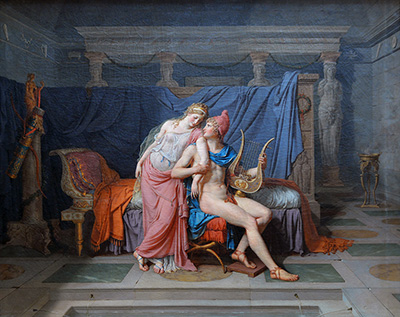Commissioned by the Comte d'Artois – who would later become Charles X of France – this painting depicts the tale of that most famous love story between Helen of 'the face that launched a thousand ships' and her ardent young lover, Paris.
While the story does not hold up for long as a love story: Helen is married to Menelaus, whom she chosen as a husband so there is no prospect that she was forced into the union, and runs off with the Trojan prince. When Paris dies, instead of returning home, she marries his brother: and then promptly betrays him to Menelaus, who after all those shenanigans was quite happy to take his flighty bride home, where upon they settled down and lived happily, or so it is assumed, ever after! Perhaps the real love story is there after all...
Whatever the story was, Jacques-Louis David chose to immortalise the two lovers together and clearly besotted with one another. Presumably Paris has just sung of his love for the beautiful Helen, judging by the lyre that sits on one thigh, still held in one hand, while the other holds Helen's arm, perhaps in the moments leading up to intimacy – Paris is seat on a sumptuous stool, naked, aside from his sandals and a red hat, with just the lyre's ribbons trailing into just the right place to retain his modesty. While his legs are turned almost fully away from Helen, his torso and upper body are swivelled towards her, as she leans on his back, almost swooning into him, it seems.
A bed is immediately behind the couple, the covers invitingly draped, while behind the bed seems to be a large canvas, covered with a blue cloth. More distantly still, and giving the impression of a lot of space, the ceiling rises high, white over pale blue walls, while behind the covered canvas stands a small temple decorated with caryatids (pillars carved into the shape of women). The whole almost gives the impression that the two have sneaked into a disused spare room, in a large mansion or palace, in order to carve out some alone time: fitting with the scandalous nature of their relationship.
The painting is full of symbolism much of it aimed at the Comte d'Artois who would – presumably – have been able to understand exactly which elements were aimed at him and why! But even without full understanding of all the elements, David's painting holds all the elements that were beginning to achieve him a great deal of fame and praise: his paintings tell their stories simply with little unnecessary background clutter, making heavy use of symbolism and striving for realism in capturing the physique, expressions and behaviour of his subjects.
David learned this from his second teacher: Joseph-Marie Vien who praised classical simplicity of narrative combined with richness of perfectly applied technique. David learned much over his long and exciting life, and was delighted to pass on this knowledge, with many students over the course of his lifetime: the most famous of these was Jean-August-Dominique Ingres, but he had up to fifty pupils at once at his peak, and continued teaching almost up to his death.
The Loves of Paris and Helen is an immense painting, oil on canvas, measuring 1.81m x 1.46m. It can be found in Room 702 of the Louvre where his love-hate relationship with the Royal Academy played out, when that noble institution was based at that location.




